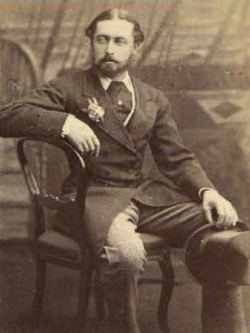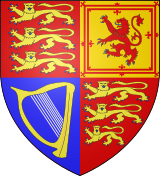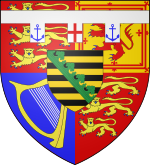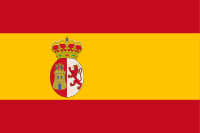Alfred, Duke of Saxe-Coburg and Gotha
| Prince Alfred | |
|---|---|
| Duke of Saxe-Coburg and Gotha Duke of Edinburgh |
|
 |
|
| Duke of Saxe-Coburg and Gotha | |
| Predecessor | Ernest II |
| Successor | Charles Edward |
| Spouse | Maria Alexandrovna of Russia |
| Issue | Prince Alfred of Edinburgh Marie, Queen of Romania Princess Victoria Melita of Edinburgh Princess Alexandra of Edinburgh Beatrice, Duchess of Galliera |
| Full name | Alfred Ernest Albert |
| Titles and styles | |
| HRH The Duke of Saxe-Coburg and Gotha HRH The Duke of Edinburgh HRH The Prince Alfred |
|
| Royal house | House of Saxe-Coburg and Gotha |
| Father | Albert of Saxe-Coburg and Gotha |
| Mother | Victoria |
| Born | 6 August 1844 |
| Baptised | 6 September 1844 St George's Chapel, Windsor |
| Died | 30 July 1900 (aged 55) |
| Occupation | Military |
Alfred, Duke of Saxe-Coburg and Gotha (Alfred Ernest Albert; 6 August 1844 – 30 July 1900) was the third Duke of Saxe-Coburg and Gotha reigning between 1893 and 1900. He was also a member of the British Royal Family, the second son and fourth child of Queen Victoria and Prince Albert of Saxe-Coburg and Gotha. He was created Duke of Edinburgh, Earl of Kent and Earl of Ulster in the peerage of the United Kingdom on 24 May 1866. He succeeded his paternal uncle Ernst as the reigning Duke of Saxe-Coburg and Gotha in the German Empire on 23 August 1893.
Contents |
Early life
Alfred was born at Windsor Castle. His mother was the reigning British monarch, Queen Victoria, the only daughter of Prince Edward Augustus, Duke of Kent and Princess Victoria of Saxe-Coburg-Saalfeld. His father was Albert of Saxe-Coburg and Gotha, the second son of Ernst I, Duke of Saxe-Coburg and Gotha. As a son of the monarch, he was styled His Royal Highness The Prince Alfred at birth, and was second in the line of succession behind his elder brother, The Prince of Wales. He was known to his family as "Affie", because he was so affable.
Alfred was christened by The Archbishop of Canterbury, William Howley, at the Private Chapel in Windsor Castle on 6 September 1844. His godparents were his maternal great-uncle, The Duke of Cambridge (represented by his son, Prince George of Cambridge); his paternal aunt, The Duchess of Saxe-Coburg and Gotha (represented by his maternal grandmother, The Duchess of Kent); and Queen Victoria's half-brother, The Prince of Leiningen (represented by The Duke of Wellington).
In 1856 it was decided that Prince Alfred, in accordance with his own wishes, should enter the Royal Navy. A separate establishment was accordingly assigned to him, with Lieutenant Sowell, R. E., as governor. He passed the examination for midshipman in August 1858, and was appointed to the HMS Euryalus. In July 1860, while on this ship, he paid an official visit to the Cape, and made a very favourable impression both on the colonials and on the native chiefs. On the abdication of King Otto of Greece, in 1862, Prince Alfred was chosen to succeed him, but political conventions of long standing rendered it impossible for the British government to accede to their wishes.
Prince Alfred, therefore remained in the navy, and was promoted lieutenant on 24 February 1863, serving under Count Gleichen on HMS Racoon, and captain on 23 February 1866, being then appointed to the command of the frigate HMS Galatea.
In 1868, Alfred survived an assassination attempt while picnicking on the beach in the Sydney suburb of Clontarf while in New South Wales.
Heir to the British throne
Alfred remained second-in-line to the British throne from his birth until 8 January 1864. His older brother Edward and his wife Alexandra of Denmark had their first son Prince Albert Victor, Duke of Clarence on this date. Any legitimate children of his older brother took priority in the succession list. Alfred became third-in-line heir to the throne.
As Edward and Alexandra continued to have children, Alfred was further demoted in the order of succession:
- On 3 June 1865 when the future George V of the United Kingdom was born, Alfred became fourth in line.
- On 20 February 1867 when Princess Louise, Princess Royal and Duchess of Fife was born, Alfred became fifth in line.
- On 6 July 1868 when Princess Victoria Alexandra of the United Kingdom was born, Alfred became sixth in line.
- On 26 November 1869 when Maud of Wales was born, Alfred became seventh.
- On 6 April 1871 when Prince Alexander John of Wales was born, Alfred became eighth in line. However, Alexander died the following day and Alfred resumed being seventh.
- On 14 January 1892, when Prince Albert Victor died, he once again became sixth in line to the throne.
| British Royalty |
|---|
| House of Saxe-Coburg and Gotha |
 |
| Descendants of Victoria & Albert |
| Victoria, Princess Royal |
| Edward VII |
| Princess Alice |
| Alfred, Duke of Saxe-Coburg & Gotha |
| Princess Helena |
| Princess Louise |
| Arthur, Duke of Connaught |
| Leopold, Duke of Albany |
| Princess Beatrice |
Duke of Edinburgh
In the Queen's Birthday Honours on 24 May 1866,[1] the prince was created Duke of Edinburgh and Earl of Ulster and Kent, with an annuity of £15,000 granted by Parliament. He took his seat in the House of Lords on 8 June.
Military career
While still in command of the Galatea, the Duke of Edinburgh started from Plymouth on 24 January 1867 for his voyage round the world. On 7 June 1867, he left Gibraltar and reached the Cape on 24 July and paid a royal visit to Cape Town on 24 August 1867 after landing at Simonstown a while earlier. He landed at Glenelg, South Australia, on 31 October.
Being the first English prince to visit Australia, the Duke was received with great enthusiasm. During his stay of nearly five months he visited Adelaide, Melbourne, Sydney, Brisbane and Tasmania.
On 12 March 1868, on his second visit to Sydney while picnicking in the beachfront suburb of Clontarf, he was wounded in the back by a revolver fired by Henry James O'Farrell. The Prince was shot just to the right of his spine, and was tended for the next two weeks by six Florence Nightingale trained nurses led by Matron Lucy Osburn who were newly arrived in Australia (February 1868).
On the evening of 23 March 1868, the most influential people of Sydney voted for a memorial building to be erected, “to raise a permanent and substantial monument in testimony of the heartfelt gratitude of the community at the recovery of HRH”. This led to a public subscription which paid for the Royal Prince Alfred Hospital's construction.
Prince Alfred soon recovered from his injury and was able to resume command of his ship and return home in early April 1868.
Henry James O'Farrell was arrested at the scene, quickly tried, convicted and hanged on 21 April 1868.
Prince Alfred reached Spithead on 26 June 1868, after an absence of seventeen months. He was also the first member of the Royal Family to visit New Zealand, arriving in 1869 on HMS Galatea. The Duke's next voyage was to India, where he arrived in December 1869. Both there and at Hong Kong, which he visited on the way, he was the first British prince to set foot in the country. The native rulers of India vied with one another in the magnificence of their entertainments during the Duke's stay of three months.
Marriage
On 23 January 1874, the Duke of Edinburgh married The Grand Duchess Maria Alexandrovna of Russia, the second (and only surviving) daughter of Tsar Alexander II of Russia and his wife Marie of Hesse and by Rhine, daughter of Ludwig II, Grand Duke of Hesse and by Rhine and Wilhelmine of Baden, at the Winter Palace, Saint Petersburg. To commemorate the occasion, a small English bakery made the now internationally popular Marie biscuit, with the Duchess' name imprinted on the its top.[2] The Duke and Duchess of Edinburgh made their public entry into London on 12 March. The marriage, however, was not a happy one, and the bride was thought haughty by London society. She insisted on taking precedence before the Princess of Wales (the future Queen Alexandra) because she and her father the Tsar considered the Princess of Wales' family (the Danish Royal family) as inferior to their own. Queen Victoria refused this demand and granted her precedence immediately after the Princess of Wales. Her father gave her the then staggering sum of £100,000 as a dowry plus an annual allowance of £28,000.
Flag Rank
The Duke of Edinburgh devoted himself to his profession, showing complete mastery of his duties and unusual skill in naval tactics. He was stationed in Malta for several years and his third child, Victoria Melita, was born there in 1876. He was promoted rear-admiral on 30 December 1878; vice-admiral, 10 November 1882; admiral, 18 October 1887; and received his baton as Admiral of the Fleet, 3 June 1893. He commanded the Channel fleet, 1883-1884; the Mediterranean fleet, 1886-1889; and was commander-in-chief at Devonport, Plymouth, 1890-1893. He always paid the greatest attention to his official duties and was most efficient as an admiral.
Percy Scott wrote in his memoirs that "as a Commander-in-Chief, the Duke of Edinburgh had, in my humble opinion, no equal. He handled a fleet magnificently, and introduced many improvement in signals and manoeuvring." He "took a great interest in gunnery."[3] "The prettiest ship I have ever seen was the [The Duke of Edinburgh's flagship] Alexandra . I was informed that £2,000 had been spent by the officers on her decoration."[4]
Duchy of Saxe-Coburg and Gotha
| Royal styles of Alfred, Duke of Saxe-Coburg and Gotha |
|
|
|
|
| Reference style | His Royal Highness |
|---|---|
| Spoken style | Your Royal Highness |
| Alternative style | Sir |
On the death of his uncle, Ernst II, Duke of Saxe-Coburg and Gotha on 22 August 1893, the vacant duchy fell to the Duke of Edinburgh, since the Prince of Wales had renounced his right to the succession. At first regarded with some coldness as a "foreigner," he gradually gained popularity. By the time of his death in 1900, he had generally won the good opinion of his subjects. The Duke was exceedingly fond of music and an excellent violinist, and took a prominent part in establishing the Royal College of Music. He was also a keen collector of glass and ceramic ware, and his collection, valued at half a million marks, was presented by his widow to the Veste Coburg, a big fortress near Coburg. When he became Duke of Saxe-Coburg and Gotha, he surrendered his British allowance of £15,000 a year and his seats in the House of Lords and the Privy Council, but he retained the £10,000 granted on his marriage in order to maintain Clarence House as his London residence.
Later life
The Duke's only son, the Hereditary Prince Alfred, became involved in a scandal involving his mistress and shot himself in January 1899, in the midst of his parents' twenty-fifth wedding anniversary celebrations. He survived, but his embarrassed parents sent him off to Merano to recover, where he died two weeks later, on 6 February. The Duke of Saxe-Coburg died of throat cancer on 30 July 1900 at Schloss Rosenau his summer residence outside Coburg. He was buried at the ducal family's mausoleum in the public Glockenburg Cemetery of Coburg. He was succeeded as the Duke of Saxe-Coburg and Gotha by his nephew, Prince Charles Edward, Duke of Albany, the posthumous son of his youngest brother, Prince Leopold, Duke of Albany because Alfred's next brother, the Duke of Connaught and his son, Prince Arthur of Connaught, had renounced their succession rights to the Duchy of Saxe-Coburg and Gotha.
Ancestors
| Ancestors of Alfred, Duke of Saxe-Coburg and Gotha | ||||||||||||||||||||||||||||||||||||||||||||||||||||||||||||||||||||||||||||||||||||||||||||||||||||||||||||||||||||||||||||||||||||||||||||||||||||||||||||||||||||||||||||||||||||||||||||||||||||||||||||||||||||||||||||||||||||||||||||||||||||||||||||||||||||||||||||||||||||||||||||||||||||||||||||||||||||||||||||||||||||||||||||||||||||||||||||||||||||||||||||||||||||||||||||||||||||||||||||||||||||||||||||||||||||||||||||||||||||||||||||||||||||||||||||||||||||||||||||||||||||||||||||||||||||||||||||||||||||||||||||||||||||||||||||||||||
|---|---|---|---|---|---|---|---|---|---|---|---|---|---|---|---|---|---|---|---|---|---|---|---|---|---|---|---|---|---|---|---|---|---|---|---|---|---|---|---|---|---|---|---|---|---|---|---|---|---|---|---|---|---|---|---|---|---|---|---|---|---|---|---|---|---|---|---|---|---|---|---|---|---|---|---|---|---|---|---|---|---|---|---|---|---|---|---|---|---|---|---|---|---|---|---|---|---|---|---|---|---|---|---|---|---|---|---|---|---|---|---|---|---|---|---|---|---|---|---|---|---|---|---|---|---|---|---|---|---|---|---|---|---|---|---|---|---|---|---|---|---|---|---|---|---|---|---|---|---|---|---|---|---|---|---|---|---|---|---|---|---|---|---|---|---|---|---|---|---|---|---|---|---|---|---|---|---|---|---|---|---|---|---|---|---|---|---|---|---|---|---|---|---|---|---|---|---|---|---|---|---|---|---|---|---|---|---|---|---|---|---|---|---|---|---|---|---|---|---|---|---|---|---|---|---|---|---|---|---|---|---|---|---|---|---|---|---|---|---|---|---|---|---|---|---|---|---|---|---|---|---|---|---|---|---|---|---|---|---|---|---|---|---|---|---|---|---|---|---|---|---|---|---|---|---|---|---|---|---|---|---|---|---|---|---|---|---|---|---|---|---|---|---|---|---|---|---|---|---|---|---|---|---|---|---|---|---|---|---|---|---|---|---|---|---|---|---|---|---|---|---|---|---|---|---|---|---|---|---|---|---|---|---|---|---|---|---|---|---|---|---|---|---|---|---|---|---|---|---|---|---|---|---|---|---|---|---|---|---|---|---|---|---|---|---|---|---|---|---|---|---|---|---|---|---|---|---|---|---|---|---|---|---|---|---|---|---|---|---|---|---|---|---|---|---|---|---|---|---|---|---|---|---|---|---|---|---|---|---|---|---|---|---|---|---|---|---|---|---|---|---|---|---|---|---|---|---|---|---|---|---|---|---|---|---|---|---|---|---|---|---|---|---|---|---|---|---|---|---|---|---|---|---|---|---|---|---|---|---|---|---|---|---|---|---|---|---|---|---|---|---|---|---|---|---|---|---|---|---|---|---|---|---|---|---|---|---|---|---|---|---|---|---|---|---|---|---|---|---|---|---|---|---|---|---|---|---|---|---|---|---|---|---|---|---|---|---|---|---|---|---|---|---|---|---|---|---|---|---|---|---|---|---|---|---|---|---|---|---|---|---|---|---|---|---|---|
|
||||||||||||||||||||||||||||||||||||||||||||||||||||||||||||||||||||||||||||||||||||||||||||||||||||||||||||||||||||||||||||||||||||||||||||||||||||||||||||||||||||||||||||||||||||||||||||||||||||||||||||||||||||||||||||||||||||||||||||||||||||||||||||||||||||||||||||||||||||||||||||||||||||||||||||||||||||||||||||||||||||||||||||||||||||||||||||||||||||||||||||||||||||||||||||||||||||||||||||||||||||||||||||||||||||||||||||||||||||||||||||||||||||||||||||||||||||||||||||||||||||||||||||||||||||||||||||||||||||||||||||||||||||||||||||||||||
Titles, styles, honours and arms
Titles and styles
- 6 August 1844–24 May 1866: His Royal Highness The Prince Alfred
- 24 May 1866–23 August 1893: His Royal Highness The Duke of Edinburgh
- 23 August 1893–30 July 1900: His Royal Highness The Duke of Saxe-Coburg and Gotha
Alfred's full style in the United Kingdom at his death was His Royal Highness The Prince Alfred Ernest Albert, Duke of Saxe-Coburg and Gotha, Duke of Edinburgh, Earl of Ulster, Earl of Kent, Knight the Most Noble Order of the Garter, Knight of the Most Ancient and Most Noble Order of the Thistle, Knight of the Most Illustrious Order of St Patrick, Knight Grand Cross of the Most Honourable Order of the Bath, Knight Grand Commander of the Most Exalted Order of the Star of India, Knight Grand Cross of the Most Distinguished Order of St Michael and St George, Knight Grand Commander of the Most Eminent Order of the Indian Empire, Knight Grand Cross of the Royal Victorian Order, Member of Her Majesty's Most Honourable Privy Council, Knight of the Order of the Black Eagle, Knight of the Star of Schwarzenberg, Knight of the Order of the Golden Fleece, Knight of the Order of the Most Holy Annunciation, Knight of the Legion of Honour, Knight of the Order of St. Stephen, Knight of the Order of St. Andrew, Ostmanieh of the Ottoman Empire.
In Germany his style and titles included Herzog von Sachsen-Coburg und Gotha, Herzog zu Sachsen, Prinz von Großbritannien und Irland, Herzog von Edinburg, Herzog zu Jülich, Kleve, und Berg, zu Engern und Westfalen, Graf von Ulster und von Kent, Landgraf in Thüringen, Markgraf zu Meissen, gefürstlicher Graf zu Henneberg, Graf zu der Mark und Ravensberg, Herr von Ravenstein und Tonna,[5] which, in English, translates to Duke of Saxe-Coburg and Gotha; Duke in Saxony; Prince of Great Britain and Ireland; Duke of Edinburgh; Duke of Jülich, Cleves and Berg, of Angria and Westphalia; Earl (Count) of Ulster and Kent; Princely Count of Henneberg; Count of the Mark and Ravensberg; Lord of Ravenstein and Tonna.
Honours
British Honours
- KG: Knight of the Garter, 1863
- KT: Knight of the Thistle, 1864
- KP: Knight of St Patrick, 1880
- GCB: Knight Grand Cross of the Bath, 1889
- GCSI: Knight Grand Commander of the Star of India, 1870
- GCMG: Knight Grand Cross of St Michael and St George, 1869
- GCIE: Knight Grand Commander of the Indian Empire, 1887
- GCVO: Knight Grand Cross of the Royal Victorian Order
- PC: Privy Counsellor, 1866

Foreign Honours
 Knight of the Black Eagle
Knight of the Black Eagle Order of the Golden Fleece
Order of the Golden Fleece Order of the Most Holy Annunciation
Order of the Most Holy Annunciation Legion of Honour
Legion of Honour Order of St. Stephen
Order of St. Stephen Order of St. Andrew
Order of St. Andrew Ostmanieh of the Ottoman Empire
Ostmanieh of the Ottoman Empire
British arms
Prince Alfred gained use of the royal arms of the United Kingdom, with an inescutcheon of the shield of Saxony, the whole differenced by a label argent of three points, the outer points bearing anchors azure, and the inner a cross gules.[6]
Issue
| Name | Birth | Death | Notes |
|---|---|---|---|
| Prince Alfred ("Young Affie") | 15 October 1874 | 6 February 1899 | Hereditary Prince of Saxe-Coburg and Gotha from 22 August 1893 |
| Princess Marie | 29 October 1875 | 18 July 1938 | married, 10 January 1893, King Ferdinand I of Romania (1865-1927); had issue |
| Princess Victoria Melita ("Ducky") | 25 November 1876 | 2 March 1936 | married (1), 19 April 1894, Ernst Ludwig, Grand Duke of Hesse and by Rhine; had issue; divorced 21 December 1901
(2) 8 October 1905, the Grand Duke Cyril Vladimirovich of Russia; had issue |
| Princess Alexandra | 1 September 1878 | 16 April 1942 | married, 20 April 1896, Prince Ernst of Hohenlohe-Langenburg; had issue |
| Stillborn son | 13 October 1879 | 13 October 1879 | |
| Princess Beatrice | 20 April 1884 | 13 July 1966 | married, 15 July 1909, Don Alfonso, Infante of Spain, 3rd Duke of Galliera; had issue |
Legacy
Manta alfredi is commonly known as Prince Alfred's manta ray. [7]
Tristan da Cunha
Edinburgh of the Seven Seas, the main settlement of Tristan da Cunha, was named after Alfred after he visited the remote Islands in 1867 while Duke of Edinburgh.
Australia
The Royal Prince Alfred Hospital in Sydney, opened during his visit to Australia in 1868, and still one of the biggest hospitals in the city, is named for him. The Alfred Hospital in Melbourne, again one of the busiest in the country, is named after Queen Victoria's second son despite the fact that he never visited the city.
Prince Alfred College, (In Adelaide), was opened by the Prince Himself, during his visit in 1869. Prince Alfred is a all Boys college R-12. The college serves the outer communities with a successful 8 to 12 boarding house. Prince Alfred college continues to be a dominate school in Adelaide, succeeding academically, and in various sports such as Australian football, Cricket, Hockey, Tennis, Rowing and basketball to name a few.
South Africa
A Prince Alfred Street can be found in Pietermaritzburg, Queenstown, Grahamstown, Durban and Caledon. There is some opposition to Prince Alfred Street in Durban being renamed Florence Nzama Street. In Port Elizabeth there is a Prince Alfred‘s Terrace.
Port Elizabeth‘s 2010 FIFA World Cup stadium is being constructed in Prince Alfred Park.
Prince Alfred sailed into Port Elizabeth on 6 August 1860 and celebrated his 16th birthday among its citizens.[8]
There was a Prince Alfred Hospital in Grahamstown for many years.
The Alfred Rowing Club was established in 1864 and was housed under the pier at Table Bay. It was named after Prince Alfred, Duke of Edinburgh, who visited the Cape in the 1860. It is the oldest organised sporting club in South Africa.[2]
The Prince Alfred Primary School is situated in Pietermaritzburg.
The Port Elizabeth Rifle Corps was formed in 1856 under Sir George Grey’s scheme to have a volunteer force to help secure the borders of the Cape Colony. Four years later the it provided a Royal Guard to Prince Alfred and reportedly bore itself so well that, at the suggestion of the Governor, the Prince gave permission for it to be renamed Prince Alfred's Guard. It bears the name to the present day.
The opening ceremony of the South African Library [3] was performed by Prince Alfred in 1860. An impressive portrait of the Prince hangs in the main reading room.[4]
The Port Elizabeth chapter of the Memorable Order of the Tin Hat, a veterans association, is known as the Prince Alfred Shellhole.[5]
Prince Alfred's Hamlet is a small town in the Western Cape province.
Port Alfred, on the Kowie River in the Eastern Cape, was originally known as Port Frances after the daughter-in-law of the governor of the Cape Colony, Lord Charles Somerset.[6]
Of all the passes built in South Africa by the famous Andrew Geddes Bain and his son, Thomas, Prince Alfred's Pass remains, for many people, a favourite because of its lavish variety winding through some of the world's most unspoiled scenery.[7]
Philately
One of the stamp collectors in the Royal Family, he was elected honorary president of The Philatelic Society, London in 1890. He may have inspired his nephew George, later King George V, who benefited the sale of his collection by Alfred to his brother, the Prince of Wales. The merging of Alfred's and George's collections gave birth to the Royal Philatelic Collection.[9]
Footnotes
- ↑ Yvonne's Royalty: Peerage
- ↑ La Tienda, 2-Pack Maria Cookies by Cuetera, http://www.tienda.com/food/products/co-01-2.html, retrieved on 2007-11-09
- ↑ p61 Fifty Years in the Royal Navy
- ↑ p61 Fifty Years in the Royal Navy
In those days "the Admiralty did not supply sufficient paint or cleaning material for keeping the ship up to the required standard, the officers had to find the money for buying the necessary housemaiding material." - ↑ Sandner, Harold. "4.0 Herzog Alfred" (in German). Das Haus von Sachsen-Coburg und Gotha 1826 bis 2001. Andreas, Prinz von Sachsen-Coburg und Gotha (preface). 96450 Coburg: Neue Presse GmbH. pp. 119. ISBN 3000085254.
- ↑ Heraldica – British Royal Cadency
- ↑ [1]
- ↑ http://www.theherald.co.za/colarc/hughb/hb07122007.htm]
- ↑ Courtney, Nicholas (2004). The Queen's Stamps. ISBN 0413772284, pages 28-29.
|
Alfred, Duke of Saxe-Coburg and Gotha
House of Saxe-Coburg and Gotha
Cadet branch of the House of Wettin
Born: 6 August 1844 Died: 30 July 1900 |
||
| German royalty | ||
|---|---|---|
| Preceded by Prince Albert |
Heir to Saxe-Coburg and Gotha as heir presumptive 14 December 1861 – 22 August 1893 |
Succeeded by Prince Alfred |
| Preceded by Ernst II |
Duke of Saxe-Coburg and Gotha 1893–1900 |
Succeeded by Charles Edward |
| Peerage of the United Kingdom | ||
| Preceded by New Creation |
Duke of Edinburgh 1866–1900 |
Succeeded by Title Extinct |
|
||||||||||||||||||||||||||||||||||||||
|
|||||
- McKinlay, Brian The First Royal Tour, 1867-1868, (London: Robert Hale & Company, c1970, 1971) 200p. ISBN 0 7091 1910 0